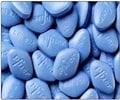
Details of the dissolving microneedle patches and immunization benefits observed in experimental mice have appeared online in the journal Nature Medicine. Conducted by researchers from Emory University and the Georgia Institute of Technology, the study is believed to be the first to evaluate the immunization benefits of dissolving microneedles.
Mark Prausnitz, a professor in the Georgia Tech School of Chemical and Biomolecular Engineering, said: "In this study, we have shown that a dissolving microneedle patch can vaccinate against influenza at least as well, and probably better than, a traditional hypodermic needle."
Just 650 microns in length and assembled into an array of 100 needles for the mouse study, the dissolving microneedles penetrate the outer layers of skin. Beyond their other advantages, the dissolving microneedles appear to provide improved immunity to influenza when compared to vaccination with hypodermic needles.
Richard Compans, professor of microbiology and immunology at Emory University School of Medicine, said: "The skin is a particularly attractive site for immunization because it contains an abundance of the types of cells that are important in generating immune responses to vaccines,"
In the study, one group of mice received the influenza vaccine using traditional hypodermic needles injecting into muscle; another group received the vaccine through dissolving microneedles applied to the skin, while a control group had microneedle patches containing no vaccine applied to their skin. When infected with influenza virus 30 days later, both groups that had received the vaccine remained healthy while mice in the control group contracted the disease and died.
Advertisement
"Another advantage of these microneedles is that the vaccine is present as a dry formulation, which will enhance its stability during distribution and storage," said Ioanna Skountzou, an Emory University assistant professor.
Advertisement
Sean Sullivan, the study's lead author from Georgia Tech, said: "We envision people getting the patch in the mail or at a pharmacy and then self administering it at home. Because the microneedles on the patch dissolve away into the skin, there would be no dangerous sharp needles left over."
The microneedle arrays were made from a polymer material, poly-vinyl pyrrolidone, that has been shown to be safe for use in the body. Freeze-dried vaccine was mixed with the vinyl-pyrrolidone monomer before being placed into microneedle molds and polymerized at room temperature using ultraviolet light.
In many parts of the world, poor medical infrastructure leads to the re-use of hypodermic needles, contributing to the spread of diseases such as HIV and hepatitis B. Dissolving microneedle patches would eliminate re-use while allowing vaccination to be done by personnel with minimal training.
Though the study examined only the administration of flu vaccine with the dissolving microneedles, the technique should be useful for other immunizations. If mass-produced, the microneedle patches are expected to cost about the same as conventional needle-and-syringe techniques, and may lower the overall cost of immunization programs by reducing personnel costs and waste disposal requirements, Prausnitz said.
Before dissolving microneedles can be made widely available, however, clinical studies will have to be done to assure safety and effectiveness. Other vaccine formulation techniques may also be studied, and researchers will want to better understand why vaccine delivery with dissolving microneedles has been shown to provide better protection.
Prausnitz said: "The dissolving microneedle patch could open up many new doors for immunization programs by eliminating the need for trained personnel to carry out the vaccination. This approach could make a significant impact because it could enable self-administration as well as simplify vaccination programs in schools and assisted living facilities."
Source-ANI








